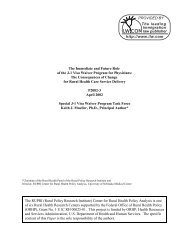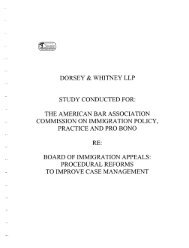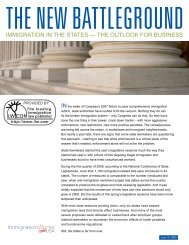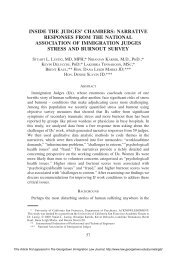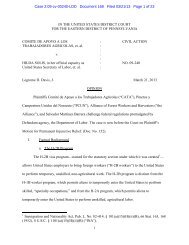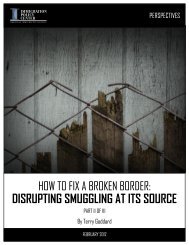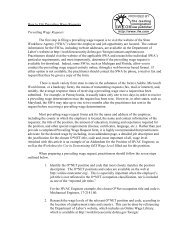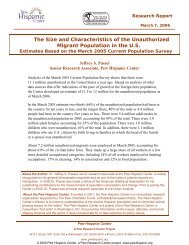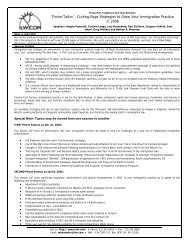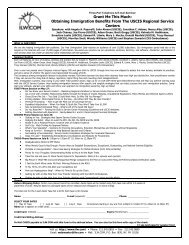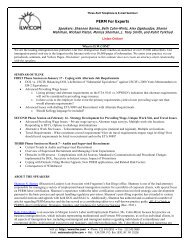What Determines Immigration's Impact? Comparing Two ... - ILW.com
What Determines Immigration's Impact? Comparing Two ... - ILW.com
What Determines Immigration's Impact? Comparing Two ... - ILW.com
Create successful ePaper yourself
Turn your PDF publications into a flip-book with our unique Google optimized e-Paper software.
NBER WORKING PAPER SERIES<br />
WHAT DETERMINES IMMIGRATION’S IMPACT?<br />
COMPARING TWO GLOBALCENTURIES<br />
Timothy J. Hatton<br />
Jeffrey G. Williamson<br />
Working Paper 12414<br />
http://www.nber.org/papers/w12414<br />
NATIONAL BUREAU OF ECONOMIC RESEARCH<br />
1050 Massachusetts Avenue<br />
Cambridge, MA 02138<br />
July 2006<br />
We are grateful to Alan Taylor for help with some of the data used here. Williamson acknowledges with<br />
pleasure financial support from the National Science Foundation SES-0001362 and the Harvard Faculty of<br />
Arts and Sciences. Hatton gratefully acknowledges support under Australian Research Council Discovery<br />
Grant DP0557885. The views expressed herein are those of the author(s) and do not necessarily reflect the<br />
views of the National Bureau of Economic Research.<br />
©2006 by Timothy J. Hatton and Jeffrey G. Williamson. All rights reserved. Short sections of text, not to<br />
exceed two paragraphs, may be quoted without explicit permission provided that full credit, including ©<br />
notice, is given to the source.
<strong>What</strong> <strong>Determines</strong> Immigration’s <strong>Impact</strong>? <strong>Comparing</strong> <strong>Two</strong> Global Centuries<br />
Timothy J. Hatton and Jeffrey G. Williamson<br />
NBER Working Paper No. 12414<br />
July 2006<br />
JEL No. N3, F22, J3<br />
ABSTRACT<br />
Can history shed light on the modern debate about immigration’s labor market impact in high wage<br />
economies? This paper examines the relationship between migration and capital flows in the age of<br />
mass migration before 1914, the so-called first global century. It then assesses the effects of<br />
immigration on wages and employment with and without international capital mobility in first global<br />
century and today, that is, the second global century. The paper then explores the links between these<br />
economic relationships and immigration policy. It concludes with an explanation for the apparent<br />
difference in immigration’s impact in the two global centuries, and thus on policy.<br />
Timothy J. Hatton<br />
Department of Economics<br />
University of Essex<br />
Wivenhoe Park<br />
Colchester CO4 3SQ<br />
UNITED KINGDOM<br />
hatton@essex.ac.uk<br />
Jeffrey G. Williamson<br />
Department of Economics<br />
Harvard University<br />
Cambridge, MA 02138<br />
and NBER<br />
jwilliam@fas.harvard.edu
1. INTRODUCTION<br />
The impact of immigration on native-born workers has been under debate ever since the<br />
Irish flooded British cities early in the first industrial revolution. Over the two centuries since<br />
then, interest heightened as democracy began to give labor the vote. When labor got the majority<br />
of the votes, analysis focused increasingly on identifying the effects of immigration on wage and<br />
employment out<strong>com</strong>es for non-immigrants, or what we will call here the native-born. While this<br />
question has thus be<strong>com</strong>e an important part of the research agenda on recent immigration, it has<br />
also occupied economic historians interested in the age of mass migration before 1914, or what<br />
has <strong>com</strong>e to be called the first global century. Indeed, we think that the first global century -- free<br />
of quotas and other policy barriers – often offers clearer insights in to the impact of immigration<br />
than does the present global century. When making the <strong>com</strong>parison between these two global<br />
centuries, however, one must take care to control for the state of the world capital market. That is,<br />
we need to know whether international capital flows magnifies or attenuates the wage and<br />
employment out<strong>com</strong>es of international migration. Once we have the answer, we are better armed<br />
to make an assessment of immigration’s impact conditional on whether we are looking at<br />
historical episodes where capital flows freely across borders or not.<br />
The rest of the paper is organized as follows. First, it explores the correlations between<br />
the international movements of labor and capital in the late nineteenth century greater Atlantic<br />
economy. Next, it poses some counterfactuals to quantify the effects of migration in the presence<br />
and absence of international capital mobility. This is followed by an overview of the effects of<br />
immigration on the labor market, in both global centuries. The historical evolution of policy is<br />
then linked to labor market out<strong>com</strong>es of immigration in the presence and absence of international<br />
capital mobility. The paper concludes with some <strong>com</strong>ments about the similarities and differences<br />
in the effects of immigration between the late nineteenth century and the present, and their<br />
implications for immigration policy.<br />
2. DID CAPITAL CHASE LABOR IN THE FIRST GLOBAL CENTURY?<br />
Did capital chase after labor in the past or did it move in the opposite direction? The<br />
answer has important implications for the effects of migration on labor markets in sending and<br />
receiving economies. The simplest two-factor Heckscher-Ohlin (HO) model predicts that capital<br />
and labor should move in opposite directions: capital scarce countries should attract capital and<br />
labor scarce countries should attract labor. Of course, the real world is made much more<br />
3
<strong>com</strong>plicated by the presence of specific factors – like natural resources – as well as by differences<br />
in technology.<br />
So, did labor and capital flow in the same or opposite directions in the first global century<br />
before World War I? Table 1 <strong>com</strong>pares decade average rates of intercontinental emigration or<br />
immigration with the net capital flow from or to the same country. The migration flows (per<br />
thousand of the source or receiving country population) are measured gross and they ignore flows<br />
within continents, while the capital flows are constructed from balance of payments statistics. As<br />
the table shows, migration inflows were typically ac<strong>com</strong>panied by capital inflows in the New<br />
World economies. The principal sources of foreign capital, the UK and Germany, also had major<br />
outward flows of migrants, but elsewhere in Europe the picture is more mixed. In countries like<br />
Sweden and Finland persistent outward flows of migrants were ac<strong>com</strong>panied by persistent inward<br />
flows of foreign capital.<br />
[Table 1 and Figure 1 about here]<br />
It would be more appropriate to measure population movements net of return migration<br />
and also to take into account the substantial migrations within Europe, but such data are much<br />
scarcer for the first global century. It is, however, possible to make such adjustments for a more<br />
limited sample from the 1890s and 1900s. The relationship between total net migration and net<br />
capital flows is depicted in Figure 1. The overseas countries absorbed both capital and labor, and<br />
five European nations sent out both (France, Germany, Italy, Spain and the UK), but the other<br />
five European countries in the sample sent out labor but not capital (Scandinavia and the<br />
Netherlands). While the correlation is hardly perfect, it does appear that capital chased after labor<br />
in the first global century. In any case, the evidence certainly does not support the conventional<br />
HO prediction that capital and labor flow in opposite directions. Figure 1 also implies that, in the<br />
labor scarce overseas economies, capital flows muted any downward pressure on real wages and<br />
any upward pressure on unemployment rates among the native-born that would otherwise have<br />
been induced by the mass migration. That is, while immigrants augmented labor supplies, capital<br />
inflows financed accumulation and thus augmented labor demand.<br />
3. HOW MUCH DIFFERENCE DID CAPITAL MOBILITY MAKE IN THE<br />
FIRST GLOBAL CENTURY?<br />
<strong>What</strong> were the effects of mass migration before World War I? It is important to establish<br />
these magnitudes since they relate directly to the evolution of policy at that time. After all, quotas<br />
and other immigration restrictions were imposed in all labor scarce overseas economies after the<br />
4
First World War. Thus, we need to know whether the dramatic policy change was driven by<br />
perceptions of immigration’s labor market impact.<br />
A question less often asked is how the in<strong>com</strong>es and wages of those left behind in the<br />
sending countries were affected. Did mass migrations reduce the real wage in receiving countries<br />
and increase the real wage in sending countries and if so by how much? And did the process of<br />
international migration lead to convergence across countries in wages and living standards? Such<br />
estimates are often based on partial equilibrium analysis, but this seems inappropriate for such<br />
large international flows that are likely to have had substantial economy-wide effects.<br />
Over the last decade or so, a number of studies have examined the effects of mass<br />
migration using <strong>com</strong>putable general equilibrium (CGE) models. The effects of migration on real<br />
wages for the United States and Great Britain from one such study appear in Table 2 (Hatton and<br />
Williamson 1998: Chps. 9, 10). The calculations use a multi-sector <strong>com</strong>petitive general<br />
equilibrium open economy model based on three factors (labor, capital, and land). A key<br />
characteristic of the CGE model is that land is specific to agriculture and immobile. Furthermore,<br />
the model has three sectors: agriculture and manufacturing produce tradable goods (with<br />
manufactures imperfectly substitutable in international markets), while services are non-tradable.<br />
The CGE is calibrated for a particular date, and the counterfactual explores the impact of<br />
increases (or reductions) in the host country labor force by the amount contributed by<br />
international migration for a period up to that date.<br />
[Table 2 about here]<br />
Our calculations indicate that had there been no US immigration from 1870 to 1910<br />
(from any source, not just Britain), the 1910 labor force would have been about 27 percent<br />
smaller. Similarly, in the absence of emigration from the Britain between 1870 and 1910 (to any<br />
destination, not just the US), the British labor force would have been 16 percent larger than it<br />
actually was in 1910. 1 The counterfactual suggests that the US real wage would have been 34<br />
percent higher than it actually was in 1910 and the British real wage would have been about 12<br />
percent lower (Table 2). These results depend largely on the fact that land and capital are held at<br />
their actual values in 1910 and that there are strong diminishing returns to labor. As a result, the<br />
US rate of return on capital falls by almost 24 percent in the absence of immigration and the<br />
British rate rises by almost 13 percent in the absence of emigration.<br />
1 Great Britain excluded Ireland. The counterfactual labor force calculations take account of the differences in<br />
participation rates between immigrants (or emigrants) and the respective native populations, which result from the age<br />
and sex selectivity of migration. They also take into account contribution to the labor force of the children of migrants.<br />
If the children of the migrants are ignored, the US labor force would have been about 18 percent smaller in the absence<br />
of immigration and the British labor force would have been about 10 percent larger in the absence of emigration.<br />
5
But what if we allow capital to be perfectly mobile between countries? This assumption<br />
seems much more plausible than the assumption of world capital immobility made in the previous<br />
counterfactual. After all, we have seen (Figure 1) that capital chased after labor across the<br />
Atlantic, presumably responding to the immigration-induced increase in US returns and the<br />
emigration-induced fall in British returns. Suppose, therefore, we hold the host country rate of<br />
return on capital constant, 2 allowing capital flows to mitigate the effects of diminishing returns on<br />
real wages. Table 2 shows that capital mobility reduces dramatically the effect of migration on<br />
real wages. In the absence of immigration, the US real wage would have been about 9 percent<br />
higher (in an economy with much less capital), and in the absence of emigration, the British real<br />
wage would have been almost 7 percent lower than it actually was. The effects with capital<br />
mobility are much smaller than those without capital mobility, but they are still substantial. This<br />
is mainly because land, which was a very important factor of production in the US economy<br />
before 1914, remains fixed in the counterfactual. 3<br />
Similar results have been obtained for other countries. Post-famine Ireland was a poor<br />
and largely agricultural country, which experienced massive emigration. Even after the<br />
immediate effects of the famine of the 1840s, the Irish home population continued to fall—from<br />
6.5 million in 1851 to 4.4 million in 1911. At the same time, the share of the Irish labor force in<br />
agriculture declined, while real wages (both rural and urban) grew more rapidly than almost<br />
anywhere else in Europe. A conservative estimate has it that the Irish labor force would have<br />
been 49 percent higher in 1911 had it not been for the emigration that took place after 1851. 4 In<br />
the absence of emigration, urban real wages would have been 19 percent lower and agricultural<br />
wages 16 percent lower (Boyer et al. 1994: p. 235). 5 But if capital were allowed to flow into<br />
Ireland in response to the now larger labor force, the effects on the real wage would be much<br />
smaller—a 6 percent fall in both rural and urban real wages. Once again, experience from the first<br />
global century shows that the effects of migration on wages were greatly attenuated by capital<br />
mobility.<br />
2 That is, we assume that the US was a price taker in world capital markets: it could get all the financial capital it<br />
wanted at the world interest rate.<br />
3 For the effects on land rents and the wage rental ratio see O’Rourke et al. (1994). For a wider analysis of wage rental<br />
ratios in the Atlantic economy, see O’Rourke and Williamson (1999).<br />
4 This counterfactual estimate of the Irish population in 1911 is described as conservative because it allows for some of<br />
the emigrants to be ‘replaced’ through a higher birth rate (hence less emigration would imply fewer births). If this<br />
effect is not allowed to operate then the counterfactual population would be 123 percent higher than the actual level in<br />
1911.<br />
5 It is also worth noting that in this counterfactual scenario GNP increases by 42 percent while GDP per capita falls by<br />
5 percent; land rents still rise by as much as 39 percent.<br />
6
In 1870 the average real wage in five New World countries was 108 percent higher than<br />
the average wage in 12 Old World countries, but by 1910 that gap had fallen to 85 percent. 6 That<br />
is, there was some wage convergence between the labor scarce New World and labor abundant<br />
Europe. There was also some convergence within Europe so that, overall, a 17-country index of<br />
real wage dispersion fell by 28 percent between 1870 and 1910. The effects of international<br />
migration on real wage dispersion across the 17 Atlantic economy countries can be seen in Table<br />
3. These counterfactuals are obtained from a three-factor production function (Taylor and<br />
Williamson 1997). In the absence of the mass migration between 1870 and 1910, there would<br />
have been divergence rather than convergence in real wages: dispersion would have increased by<br />
7 percent rather than decreasing by 28 percent (Table 3). Most of that fall was due to the<br />
changing gap between the New World and Europe which would have risen from 108 percent to<br />
128 percent rather than falling from 108 percent to 85 percent, a difference of 43 percentage<br />
points.<br />
[Table 3 about here]<br />
Once again, these effects are sharply attenuated when capital is allowed to be mobile. In<br />
the absence of capital mobility, 119 percent of the real wage convergence is explained by<br />
migration (i.e. migration more than explains the convergence); in the presence of capital mobility,<br />
‘only’ 41 percent is explained by migration. Similar results are obtained for the more modest<br />
convergence that occurred in GDP per capita and GDP per worker. Migration explains 50 percent<br />
of the convergence in GDP per capita with capital immobile but only 19 percent with capital<br />
mobile. In short, international capital mobility in the first global century served to mute the<br />
impact of migration on real wages and GDP per capita by quite a bit.<br />
4. WHY ARE THE EFFECTS OF IMMIGRATION SO DIFFICULT TO OBSERVE?<br />
Economic theory and economic history both tell us that immigration reduced real wages<br />
in the host country and that emigration raised real wages in the origin country during the first<br />
global century. But both depend on the assumptions made in the analysis. We think the same is<br />
true of the contemporary literature, in which debate about the effects of immigration on the wages<br />
and employment rates of the native-born has been intense. Most modern studies suggest that the<br />
effects of immigration on wages are negligible—in sharp contrast to the effects described above<br />
for the first global century. These modern studies have been based on the so-called spatial<br />
6 The New World countries are: Argentina, Australia, Brazil, Canada, and the United States. The European countries<br />
are: Belgium, Denmark, France, Germany, Great Britain, Ireland, Italy, Netherlands, Norway, Portugal, Spain, and<br />
Sweden.<br />
7
correlations approach, which seeks to isolate the effects of immigration by correlating wage (or<br />
employment rate) changes with immigrant inflows across local areas within the receiving country.<br />
Debate about the validity of this method is well rehearsed and thus will be treated only briefly<br />
here. 7<br />
One important critique of the spatial correlations approach is the following: If there is a<br />
national labor market in which non-immigrant workers are mobile across localities, the effect of<br />
immigration will not be restricted to the cities or regions where immigrants locate. If, in response<br />
to immigrant inflows, native workers move out to other regions (or fewer move in than otherwise)<br />
then the wage and employment effects will be spread across the entire economy and will not be<br />
identified by measuring the relationship between immigration and economic out<strong>com</strong>es observed<br />
across localities as in the spatial correlations approach. This debate was originally stimulated by<br />
the apparent absence of wage and employment effects following the Mariel boatlift that brought<br />
125,000 Cubans to Miami in 1980, adding about 7 percent to its labor force (Card 1990). The<br />
current state of play in this debate is best summarized by two papers, both on the US, that take<br />
opposing views. In his analysis of census data, David Card (2001) finds little evidence that<br />
immigration into major cities caused the native-born to move out. Furthermore, he finds that<br />
while immigration caused changes in the skill mix, these had little effect on relative wages. In<br />
contrast, George Borjas (2003) estimates the out<strong>com</strong>es of immigration for the native born by<br />
skill/experience groups at the national level (hence avoiding spatial mobility effects). He finds<br />
that immigration reduces the earnings for the same native-born skill/experience group, and hence<br />
that the labor demand curve does indeed slope downwards to the right.<br />
<strong>What</strong> support is there for the spatial displacement hypothesis? Table 4 provides some<br />
evidence on this issue, here for regions in the United Kingdom between 1982 and 2000. The<br />
result indicates that a net immigration of 100 foreign citizens into a region in the south of<br />
England reduced net immigration from other British regions by 43. <strong>Two</strong> lessons may be drawn<br />
from Table 4. First, it is essential to control for the demand side variables that determine internal<br />
migration when making the immigration impact assessment. Second, and even more important,<br />
Table 4 reports results for only the six (booming) southern regions since these were the ones<br />
where immigrants left a significant mark on labor markets. When all British regions are included,<br />
the measured displacement effect is much weaker. This result is hardly surprising since<br />
immigration was very small in the north <strong>com</strong>pared with other shocks to labor supply and demand.<br />
The greater the size of the immigration shock the clearer is its effect on the labor market.<br />
[Tables 4 and 5 about here]<br />
7 For summaries of the relevant literature, see Borjas (1994, 1999) and Hatton and Williamson (2005a: Chp. 14).<br />
8
Did the first global century see the same internal mobility response that we see in the<br />
second global century? Evidence from the United States suggests that it did. Table 5 gives an<br />
estimate of the effects, by decade, of immigration on the eastern and midwestern states. The<br />
estimate is strikingly similar to the contemporary estimate for the UK in Table 4. It suggests that<br />
for every 100 immigrants arriving in an eastern (gateway) state, 40 native-born were displaced to<br />
other states. An important feature of the first global century in the US was its great westward<br />
settlement, an internal migration which accelerated as the late nineteenth century progressed.<br />
Most historians see this migration as a land-induced pull from the west, while we see it as both<br />
pull from the west and an immigration-induced push from the east. In any case, whether looking<br />
at the past or the present, it is important to focus on regions and localities where there are large<br />
immigration shocks; otherwise the displacement effects will be lost in a thick fog of other<br />
influences.<br />
If the displacement effect had been one-for-one, we would observe no relative labor<br />
market effects of immigration in gateway cities and states at all—even though there may have<br />
been substantial effects at the national level. But Table 4 and 5 suggest a displacement coefficient<br />
of around 0.4, an effect that is far from fully offsetting one-for-one. Thus, we should still observe<br />
some imprint of immigration on local wage or employment out<strong>com</strong>es. Hence, other mechanisms<br />
are needed to explain the modest (or zero) effects found in so many studies. Those mechanisms<br />
could <strong>com</strong>e from internal trade in goods or from internal capital mobility. Unfortunately, there is<br />
little data available that measures regional capital mobility within countries. However, it seems<br />
reasonable to suppose that if capital is fairly mobile between countries, then it would be at least as<br />
mobile within countries. Since capital mobility attenuates immigration’s wage effects at the<br />
national level, it should have an even greater attenuating effect at the local level.<br />
5. THE LABOR MARKET EFFECTS OF BIG IMMIGRATION SHOCKS IN THE<br />
SECOND GLOBAL CENTURY<br />
The preceding discussion suggests that we should be looking for big migration shocks in<br />
order to discern clearly the effects of immigration (or possibly emigration) on real wages,<br />
employment and other labor market variables of interest. Furthermore, they must be exogenous<br />
shocks or ‘natural experiments’ in order to avoid confounding migration cause and effect.<br />
Unfortunately, the first global century offers few useful cases: although the trans-Atlantic<br />
9
migrations were very large, they were also driven largely by economic incentives. Thus, they can<br />
hardly be viewed as exogenous. 8<br />
A number of more recent natural experiments have been examined, and these have<br />
sometimes been interpreted as supporting the modest-immigration-effects-on-wages school of<br />
thought. Closer inspection, however, suggests that these widely cited cases illustrate quite large<br />
wage effects, especially if we focus on the economy-wide estimates rather than those which use<br />
the spatial correlations approach. The first natural experiment is offered by the inflow into<br />
metropolitan France from Algeria following the latter’s independence. These immigrants were<br />
largely French-born expatriates fleeing the regime change and about 900,000 of them flooded<br />
France during 1962, adding 1.9 percent to the population and 1.6 percent to the labor force.<br />
Jennifer Hunt (1992) found that the overall effect was to reduce the real wage by 1.3 percent and<br />
to increase the unemployment rate by 0.3 percentage points. Thus, the Algerian immigration<br />
shock was sufficiently large to have a clear effect on the French labor market. Indeed, it implies a<br />
labor demand elasticity of -1.3/+1.6 = -0.8, quite consistent with other aggregate labor demand<br />
elasticity estimates (Hammermesh 1993).<br />
Larger still was the influx of Portuguese retornados when independence struggles in<br />
Angola and Mozambique came to a climax in 1974-6. This caused a spike in net immigration to<br />
Portugal that peaked at 40 per thousand in 1975. 9 The 600,000 Portuguese retornados added 7<br />
percent to the Portuguese population over these few years. William Carrington and Pedro di Lima<br />
(1996: p. 344) found that the influx of retornados reduced the Portuguese real wage by 5-9<br />
percent for every 10 percent addition to the labor force (implying a labor demand elasticity lying<br />
between -0.5 and -0.9). The aggregate effect can be seen in Figure 2 where Portuguese real wages<br />
and employment are plotted as ratios to her two closest neighbors, Spain and France. This<br />
<strong>com</strong>parison is <strong>com</strong>plicated by the recession of the mid-1970s, which was particularly severe in<br />
Spain, and so the <strong>com</strong>parison with France may be more informative. The retornados were<br />
absorbed slowly into employment; even as late as 1981, their unemployment rate was 14 percent<br />
<strong>com</strong>pared with 6 percent for other workers. But the gap diminished and, as Figure 2 shows,<br />
relative employment rose and the relative real wage fell as the immigrants were gradually<br />
absorbed.<br />
[Figures 2, 3 and 4 about here]<br />
8 The great Irish famine might seem like a good natural experiment. However, it was not exogenous to the Irish<br />
economy and hence the effects of emigration on Ireland would be hard to distinguish from other effects of the famine.<br />
While it might be possible to look at the effect of famine migration on the US economy, data constraints would make<br />
this a difficult task.<br />
9 It is also worth noting the persistent net out-migration from Portugal during the guestworker era and the reversal of<br />
that trend after the arbeitstopp in 1973/4.<br />
10
An even clearer natural experiment is offered by the movement of Russian Jews to Israel<br />
when the Soviet Union lifted its restriction on emigration late in 1989. Israel’s immigration rate<br />
averaged 3.7 per thousand of the population in the decade before 1990. It surged to 35 per<br />
thousand in 1990-1 and then continued at 10-15 per thousand for the rest of the decade. This<br />
immigration shock added 610,000, equivalent to 7 percent of the population, in the first two<br />
years, and by the mid-1990s the influx amounted to a million or about 12 percent of the<br />
population. The effects on the labor market were equally dramatic: the working age population<br />
increased by 8 percent up to 1992 and by 16 percent up to 1997. The aggregate data suggests that<br />
this influx left a clear mark on the labor market. 10 Figure 3 plots percentage deviations from<br />
logarithmic trends, calculated for the pre-shock period 1980-1989. The labor force was more than<br />
15 percent above trend by the mid-1990s. Employment rose more slowly at first, as the<br />
immigrants were absorbed gradually into employment, but by the mid 1990s it was more than 20<br />
percent above trend. 11 Relative to its trend, the real wage plunged in the early 1990s and then<br />
hovered at about 10 percent below trend for the rest of the decade. This implies a labor demand<br />
elasticity of -0.67, quite consistent with the estimates for France and Portugal cited above,<br />
ranging between -0.5 and -0.9. It is also consistent with the recent Borjas finding that US<br />
immigrants do indeed crowd out native-born and that “the labor demand curve is downward<br />
sloping” (Borjas 2003).).<br />
These cases provide clear and decisive evidence that immigration lowers real wages. But<br />
what about international capital flows? Did they serve to mitigate the effects on wages in these<br />
modern cases, much like we observe for the first global century? The sudden increase in the<br />
Israeli labor supply reduced the capital-labor ratio and increased the return on capital. As a result,<br />
gross investment in machinery and equipment increased from 12 percent of the stock in the 1980s<br />
to 19 percent in 1994-6 (Cohen and Hsieh 2000: p. 19). This accumulation response was financed<br />
largely from abroad. As Figure 4 shows, the current account deficit as a percentage of GDP<br />
increased by about 8 percentage points between 1990 and 1996. We conclude that labor market<br />
adjustments would have been much more painful and the wage effects would have been much<br />
larger in the absence of elastic international capital market responses. In contrast, adjustments<br />
10 For studies of the economic out<strong>com</strong>es of this immigration shock see Friedberg (2001), Cohen and Hsieh (2000), and<br />
Eckstein and Cohen (2003).<br />
11 In 1991 the unemployment rate was 37.3 percent among immigrants, <strong>com</strong>pared with 9 percent among nonimmigrants.<br />
The difference evaporated over the 1990s and by 2000 it was just two percentage points, 10.4 percent for<br />
immigrants and 8.4 percent for non-immigrants.<br />
11
through induced changes in the <strong>com</strong>position of output and the structure of trade do not seem to<br />
have been important. 12<br />
6. WHY DID THE INTERNATIONAL LABOR MARKET STAY SO OPEN FOR SO LONG?<br />
We have argued that large-scale immigration has tended to reduce economy-wide real<br />
wages, both in the recent and more distant past. In democratic economies where most of the votes<br />
are held by labor, it might be expected that immigration should generate strong anti-immigrant<br />
public opinion. This expectation suggests a paradox. Why did the late nineteenth century labor<br />
scarce economies stay so open to immigration for so long?<br />
The end of the era of free immigration is traditionally seen as the closing of the door by<br />
the United States, with the imposition of a literacy test in 1917 followed by the first quota Act in<br />
1921, and further tightening of the quota in 1924 and 1928. As Claudia Goldin (1994) puts it:<br />
“The American policy of virtually unrestricted immigration was transformed, almost<br />
overnight, into a quota system that would last, virtually unchanged, until 1965. The<br />
ultimate switch in policy is not hard to explain. The perplexing part of the legislative<br />
history of immigration restriction is its timing. More astonishing than the closing of the<br />
door in 1921 is that it remained open despite twenty-five years of assault during which 17<br />
million immigrants from among the poorest nations in Europe found refuge in America<br />
(1994: p. 223).”<br />
Other New World countries also tightened their immigration controls, with the decisive shifts<br />
<strong>com</strong>ing a decade later.<br />
Why didn’t immigration controls <strong>com</strong>e sooner? Part of the answer is suggested by Figure<br />
5, where we plot an average index of the immigration policy stance among five New World<br />
countries (Argentina, Australia, Brazil, Canada, US). The index for each country varies from +5<br />
(strong anti-immigration policy) to -5 (strong pro-immigration policy). These indices are based<br />
on a variety of changing conditions like restricting the immigration of certain types of<br />
individuals, restricting immigrant rights upon arrival, imposing head taxes, applying literacy tests<br />
and immigration quotas, removing subsidies for passage, and no longer offering land grants to<br />
immigrants. The index illustrates that restrictive immigration measures were on the rise before<br />
1917; hence, there is plenty of evidence confirming policy backlash even before the quotas.<br />
12 Although the immigrants were more highly skilled than the natives, no shift in the output <strong>com</strong>position towards skill<br />
intensive sectors took place (Cohen and Hsieh 2000: p. 15). One reason for this apparently counter-intuitive result is<br />
that the Russian immigrants were unable to use their skills effectively because many of them lacked fluency in Hebrew.<br />
12
Nevertheless, these measures did little to stem the immigrant tide until the tougher exclusionary<br />
policies were enacted, beginning in the second decade of the twentieth century.<br />
[Figure 5 about here]<br />
Ashley Timmer and Jeffrey Williamson (1998) have examined the determinants of these<br />
measures of policy. They find that immigration policy became more restrictive as the number of<br />
immigrants increased, as the wage of unskilled workers fell relative to average in<strong>com</strong>e, and as the<br />
share of immigrants from poor and ethnically different countries increased. They interpret the<br />
results as reflecting the downward pressure on real wages, particularly at the lower end of the<br />
skill distribution. In addition they find a high degree of persistence in policy, suggesting that it<br />
responded to these forces only with fairly long lags. Finally, they suggest that there was some<br />
direct policy spillover from one country to another especially from the United States, the big<br />
policy leader, to the small policy followers.<br />
Given the accumulation of anti-immigration forces in the late nineteenth century, why<br />
were the most restrictive policies delayed so long? A series of bills were presented to US<br />
Congress aiming to restrict immigration by requiring that immigrants pass a literacy test. As early<br />
as 1897, the House vote favored restriction in the form of the Literacy Act but the antiimmigration<br />
Congress was not able to override the presidential veto until 1917. Looking across<br />
US cities, Goldin (1994) found that wage growth was slower the greater was the growth in the<br />
proportion of immigrants. 13 She also found that the greater the wage effect, the more likely that<br />
the local representative in Congress would vote to restrict immigration (Goldin 1994: p. 254). Her<br />
results seem to be consistent with correlates of policy noted by Timmer and Williamson.<br />
Given that anti-immigrant sentiment was so strong in US Congress, it would not have<br />
taken very much to tip the balance in favor of restriction. A collapse in world capital markets<br />
during the First World War and the interwar years offered one such ‘tipping’ trigger: since capital<br />
mobility helped mute the impact of immigration on real wages and unemployment, the reduction<br />
of capital mobility should have heightened the impact. This ‘tipping’ trigger is usually neglected<br />
in immigration policy accounts of this period. To repeat, most small New World economies were<br />
not able to import the same amounts of capital in the 1920s, and international capital flows dried<br />
up <strong>com</strong>pletely in the 1930s. It therefore became much harder to absorb immigrants without<br />
substantially reducing the wages of natives. The Great War offered another ‘tipping’ trigger,<br />
since it heightened some anti-European feelings. The Great Depression offered yet a third<br />
‘tipping’ trigger, this time for the smaller policy-lagging New World countries. The literacy test<br />
13 This may seem inconsistent with the argument presented earlier that internal migration served to dissipate the effects<br />
of foreign immigration on wages across the entire economy. But since the displacement effect is less than one there<br />
may still be some local effect.<br />
13
first introduced in Natal in 1897 was adopted by the newly Federated Australia in 1901 and by<br />
Canada in 1910. But quotas and other restrictions were to wait until the thirties when they were<br />
introduced by Australia and South Africa (1930), followed by New Zealand (1931), Canada<br />
(1932) and Brazil (1934). This severe tightening of immigration policies is often seen as a direct<br />
response to the Great Depression, but we think the latter acted instead as a trigger that unleashed<br />
the effects of much more fundamental and longer-term forces.<br />
7. DOES HISTORY OFFER LESSONS FOR TODAY’S IMMIGRATIONS?<br />
We have argued that there are strong parallels between the effects of mass migration in<br />
the past and present, but one must guard against unqualified history lessons. Three major<br />
differences between the first and the second global centuries suggest caution with lessons of<br />
history.<br />
Late nineteenth century immigration had significant wage effects even in the presence of<br />
capital mobility. The main reason seems to be that land (and, more generally, natural resources)<br />
was a much more important input to aggregate production than it is today. The more open are<br />
capital markets, and the less important are immobile factors such as land, the smaller should be<br />
the wage effects of immigration. Consequently, the host country policy backlash that arises from<br />
wage effects should be smaller today than it was a century ago. On the other hand, in the less<br />
developed world where land and agriculture loom much larger, emigration is still likely to<br />
increase the real wage of those left behind, just as it did in Ireland and elsewhere in poor Europe<br />
in the late nineteenth century. 14<br />
While land has be<strong>com</strong>e less important, skills have be<strong>com</strong>e more important. And if<br />
unskilled migrants (unskilled relative to host country natives) dominate the flow from poorer to<br />
richer countries, then skills might be viewed as an immobile factor just as land was in the<br />
nineteenth century. But there is one big difference. Skilled workers have votes and they now<br />
constitute the majority in most developed countries whereas landowners were in the minority in<br />
the late nineteenth century. If skilled and unskilled labor are treated as different factors of<br />
production then the evidence suggests that the effect of unskilled immigration on the skilled wage<br />
rate is ambiguous and most empirical studies find it to be small. Studies that find negative wage<br />
effects mainly find them in the unskilled segment of the labor market. Since the median voter in<br />
today’s high wage host country is skilled, rather than unskilled – as was true in the first global<br />
14 For evidence of the effect of migration on real wages in modern Africa, see Hatton and Williamson (2003).<br />
14
century, the negative labor market effects may have less impact on public opinion today, and<br />
therefore on policy, than they did a century ago.<br />
The third change is perhaps the most important for policy, and this concerns the fiscal<br />
impact of immigration. A century ago, state welfare programs were miniscule, but they grew<br />
rapidly in the 1930s, and by the 1970s welfare spending loomed large in all western economies<br />
(Lindert 2004). It is also clear that less skilled immigrants are more likely to be a burden on the<br />
welfare state. Thus the average native-born worker in a relatively rich country may be negatively<br />
disposed to immigration, not because of labor market <strong>com</strong>petition (as was the case in the late<br />
nineteenth century when the median voter was an unskilled worker), but because of the likely<br />
effects on the welfare budget and therefore on his or her tax liability. 15<br />
Such arguments are supported by the evidence on public opinion offered by the ISSP’s<br />
1995 module on National Identity. These data have been widely analysed and the results will be<br />
treated only briefly here. 16 Table 6 reports the average score for anti-immigration attitudes in the<br />
more developed counties in the survey. These scores range from 1 ‘immigration [to the<br />
respondent’s country] should be increased a lot’, to 5 ‘immigration should be reduced a lot’. This<br />
measure suggests that attitudes in most countries are mildly anti-immigration.<br />
[Tables 6 and 7 about here]<br />
Table 7 presents regression results that have much in <strong>com</strong>mon with earlier studies, with<br />
the difference that these include country-level variables as well as individual-level variables.<br />
Measures of ‘patriotism’ and ‘chauvinism’ derived from other attitudinal questions have the<br />
expected positive effects, supporting the view that prejudice matters. 17 Other notable results are<br />
that second generation immigrants and those with high education (more than a secondary<br />
education) are significantly less hostile to immigration than those without these characteristics.<br />
The latter result seems consistent with the notion that the more skilled have less to fear from<br />
immigration. Thus, just as the owners of land were more pro-immigration a century ago<br />
(<strong>com</strong>pared to other citizens), the owners of skills are more pro-immigration today (<strong>com</strong>pared with<br />
other citizens). As we stressed earlier, the big difference between the two global centuries is that<br />
the owners of skills <strong>com</strong>mand more votes today than the owners of land did a century ago.<br />
While the list of countries with the relevant data is short, what we do have supports the<br />
view that the richer and the more unequal the country, the more hostile are attitudes to<br />
immigration. More to the point, attitudes are more anti-immigration the more immigrants there<br />
15 It is also important to recognize the limited franchise in many countries before 1914 (Hatton and Williamson 2005b).<br />
16 For more detailed discussion of these data and econometric results using them, see Mayda (2004), and O’Rourke and<br />
Sinnott (2004).<br />
17 We follow O’Rourke and Sinnott (2004) in defining these variables. Dustmann and Preston (2000) provide other<br />
evidence of prejudice towards certain racial groups using British data.<br />
15
are and the larger is the welfare state. The richer and more unequal is the host country, the more<br />
likely are poor immigrants to depend on welfare. The larger is immigration and the bigger is the<br />
welfare state, the more costly this is likely to be for the average host country voter.<br />
In a world of capital mobility, the wage effects of immigration are attenuated. Since those<br />
capital market conditions prevailed both before 1914 and after 1970, they cannot therefore offer<br />
an explanation for the more restrictive policies today. In a world where skills matter, voters have<br />
less reason to fear the labor market impact from (relatively unskilled) immigration. Here again,<br />
this fact cannot therefore offer an explanation for the more restrictive policies today. <strong>What</strong> does<br />
offer an explanation for today’s more restrictive immigration policies is the threat to the public<br />
purse. Even if these fiscal costs are smaller than the public thinks, the perception still shapes<br />
public attitudes towards immigration. 18<br />
18 We have made no mention of racism, patriotism and xenophobia since there is no reason to think that the intensity of<br />
these attitudes changed between the two global centuries.<br />
16
REFERENCES<br />
Borjas, G. J. (1994). The Economics of Immigration. Journal of Economic Literature 32 (4),<br />
1667-717.<br />
Borjas, G. J. (1999). The Economic Analysis of Immigration. In O. Ashenfelter and D.<br />
Card (Eds.), Handbook of Labor Economics, Vol. 3A. New York: North Holland,<br />
1697-760.<br />
Borjas, G. J. (2003). The Labor Demand Curve Is Downward Sloping: Reexamining the<br />
<strong>Impact</strong> of Immigration on the Labor Market. Quarterly Journal of Economics 118 (4), 1335-74.<br />
Boyer, G. R., T. J. Hatton and K. H. O’Rourke (1994). The <strong>Impact</strong> of Emigration on Real Wages<br />
in Ireland, 1850-1914. In T. J. Hatton and J. G. Williamson (Eds.), Migration and the<br />
International Labor Market, 1850-1914. London: Routledge, 221-39.<br />
Card, D. (1990). The <strong>Impact</strong> of the Mariel Boatlift on the Miami Labor Market. Industrial and<br />
Labor Relations Review 43 (2): 247-57.<br />
Card, D. (2001). Immigrant Inflows, Native Outflows, and the Local Labor Market <strong>Impact</strong>s of<br />
Higher Immigration. Journal of Labor Economics 19 (1), 22-64.<br />
Carrington, W. J. and P. J. F. di Lima (1996). The <strong>Impact</strong> of 1970s Repatriates from Africa on the<br />
Portuguese Labor Market. Industrial and Labor Relations Review 49 (2), 330-47.<br />
Cohen, S. and C-T. Hsieh (2001). Macroeconomic and Labor Market <strong>Impact</strong> of Russian<br />
Immigration in Israel. Bar Ilan University: unpublished paper.<br />
Dustmann, C. and I. Preston (2000). Racial and Economic Factors in Attitudes to Immigration.<br />
IZA Discussion Paper 190, Bonn: IZA.<br />
Eckstein, Z and Y. Weiss (2003). On the Wage Growth of Immigrants: Israel, 1990-2000. IZA<br />
Discussion Paper 710, Bonn: IZA.<br />
Ferenczi, I. and W. F. Willcox (1929). International Migrations, Vol. I. New York: National<br />
Bureau of Economic Research.<br />
17
Friedberg, R. M. (2001). The <strong>Impact</strong> of Mass Migration on the Israeli Labor Market. Quarterly<br />
Journal of Economics 116 (4): 1373-408.<br />
Goldin, C. (1994). The Political Economy of Immigration Restriction in the United States, 1890<br />
to 1921. In C. Goldin and G. D. Libecap (Eds.), The Regulated Economy: A Historical Approach<br />
to Political Economy. Chicago: University of Chicago Press, 223-58.<br />
Hammermesh, D. S. (1993). Labor Demand. Princeton, N.J.: Princeton University Press.<br />
Hatton, T. J. and M. Tani (2005). Immigration and Inter-Regional Mobility in the UK, 1982-<br />
2000. Economic Journal (Features) 115 (November), F342-F58.<br />
Hatton, T. J. and J. G. Williamson (1998). The Age of Mass Migration: An Economic Analysis.<br />
New York: Oxford University Press.<br />
Hatton, T. J. and J. G. Williamson (2003). Demographic and Economic Pressure on Migration<br />
Out of Africa. Scandinavian Journal of Economics 105 (September), 465-86.<br />
Hatton, T. J. and J. G. Williamson (2005a). Global Migration and the World Economy: <strong>Two</strong><br />
Centuries of Policy and Performance. Cambridge, Mass.: MIT Press.<br />
Hatton, T. J. and J. G. Williamson (2005b). A Dual Policy Paradox: Why Have Trade and<br />
Immigration Policies Always Differed in Labor-Scarce Economies? NBER Working Paper<br />
11866, National Bureau of Economic Research, Cambridge, Mass. (December).<br />
Hunt, J. (1992). The <strong>Impact</strong> of the 1962 Repatriates from Algeria on the French Labor Market.<br />
Industrial and Labor Relations Review 45 (3), 556-72.<br />
Lindert, P. H. (2004). Growing Public: Social Spending and Economics Growth since the<br />
Eighteenth Century. Cambridge: Cambridge University Press.<br />
Mayda, A. M. (2004). Who Is Against Immigration? A Cross-Country Investigation of<br />
Individual Attitudes Toward Immigrants. IZA Discussion Paper 1115, Bonn: IZA.<br />
O'Rourke, K. H. and R. Sinnott (2004). The Determinants of Individual Attitudes Towards<br />
Immigration. Trinity College, Dublin: unpublished paper.<br />
O'Rourke, K. H. and J. G. Williamson (1999). Globalization and History: The Evolution of a<br />
18
Table 1<br />
Intercontinental Gross Migration and Net Capital Flows, 1860s to 1900s<br />
M=immigrants per 1000 per annum; K=net capital outflow as percent of GDP per annum<br />
1860s 1870s 1880s 1890s 1900s<br />
Austria-Hungary M 0.29 1.06 1.61 4.76<br />
K<br />
Belgium M 0.86 0.35 0.61<br />
K<br />
British Isles M 5.18 5.04 7.02 4.38 6.53<br />
K 3.47 3.79 5.55 2.95 4.56<br />
Denmark M 2.06 3.94 2.23 2.82<br />
K 0 -0.37 -2.12 -2.56 -2.94<br />
France M 0.12 0.15 0.31 0.13 0.14<br />
K 3.45 2.85 -1.80 -0.37 3.33<br />
Germany M 1.47 2.87 1.01 0.45<br />
K 0 1.43 2.30 1.60 1.32<br />
Netherlands M 0.59 0.46 1.23 0.5 0.51<br />
K 6.80 -5.28 2.14 1.80 2.46<br />
Norway M 5.76 4.73 9.52 4.49 8.33<br />
K 0 0.08 1.07 -4.46 -4.64<br />
Sweden M 5.76 4.73 9.52 4.12 4.2<br />
K -1.60 -2.06 -4.48 -1.36 -2.89<br />
Switzerland M 1.3 3.2 1.41 1.39<br />
K<br />
Finland M 1.32 2.32 5.45<br />
K -5.48 -6.42 -6.35 -5.65 -5.60<br />
Italy M 1.05 3.36 5.02 5.69<br />
K -2.91 0.12 -1.36 1.65 2.13<br />
Portugal M 1.9 2.89 3.8 5.08 5.69<br />
K<br />
Spain M 3.62 4.38 5.66<br />
K -1.88 -1.03 -0.68 0.72 0.28<br />
Canada M -8.32 -5.48 -7.84 -4.88 -16.76<br />
K 0 -7.31 -7.22 -5.06 -7.58<br />
United States M -6.49 -5.46 -8.58 -5.3 -10.2<br />
K 0 -0.54 -1.15 0.33 0.28<br />
Argentina M -9.91 -11.7 -22.17 -16.39 -29.18<br />
K 0 0 0 -3.72 -4.24<br />
Brazil M -2.04 -4.11 -7.23 -3.38<br />
K<br />
Australia M -9.08 -16.31<br />
K -16.97 -7.20 -12.17 -7.74 -3.36<br />
Sources: Migration data from Ferenczi and Willcox (1929: pp. 200-1, 209). Data for the balance of<br />
payments residual kindly supplied by Alan Taylor (Taylor 2002). Blanks indicate absence of data, but<br />
qualitative evidence suggests trivial flows.<br />
20
Table 2<br />
Counterfactual General Equilibrium Effects of Migration on Real Wages<br />
Effect on 1890 economy of no<br />
migration from 1870 to 1890<br />
Effect on 1910 economy of no<br />
migration from 1870 to 1910<br />
Capital Capital Mobile Capital Capital Mobile<br />
Immobile<br />
Immobile<br />
United States +14.4 +3.7 +34.0 +9.2<br />
Great Britain –8.8 –4.7 –12.2 –6.6<br />
Source: Hatton and Williamson (1998: p. 212). Counterfactuals use a three-sector open economy<br />
<strong>com</strong>putable general equilibrium model for each country. The counterfactual with capital immobile holds<br />
the capital stock at its actual value; the counterfactual with capital mobile holds the rate of return on capital<br />
constant.<br />
Table 3<br />
Migration and Economic Convergence in the Atlantic Economy, 1870-1910<br />
Dispersion (1870 =100) Convergence explained, 1870-<br />
1910 (percent of total)<br />
Actual, 1910 Counterfactual, Capital Capital Mobile<br />
1910<br />
Immobile<br />
Real Wages 72 107 119 41<br />
GDP per capita 82 91 50 19<br />
GDP per worker 71 91 72 23<br />
Source: Taylor and Williamson (1997: pp. 40, 42). The counterfactuals are derived from a three factor<br />
production function (labor, capital and land) calibrated for seventeen countries of the Greater Atlantic<br />
economy. The measure of dispersion used is the variance divided by the mean squared. The baseline<br />
counterfactuals reproduced here assume that: that the elasticity of factor substitution is 1; that the relative<br />
participation migrants to non-migrants is 1.65 and that the effective worker ratio (or relative efficiency) of<br />
immigrants to non-immigrants is 0.8.<br />
21
Table 4<br />
Immigration and Internal Migration: UK Regions by Year, 1982-2000<br />
NetMigR t = − 0.43 NetImR t-1 + 0.44 LogVacs t – 0.13 LogUnR t + 2.78 LogEarn t-1<br />
(2.1) (2.3) (0.3) (2.4)<br />
– 0.83 LogHseP t + 0.94 ΔLogHseP t ; Adj R 2 = 0.92<br />
(2.2) (1.7)<br />
Note: ‘t’ statistics in parentheses.<br />
Sample: Balanced panel of region/years. The regions are: Greater London, Rest of the Southeast, East<br />
Anglia, East Midlands, West Midlands and South West.<br />
Variable definitions: NetMigR = net migration rate into the region from elsewhere in the UK, per 1000 of<br />
the region’s population; NetImR = net immigration from abroad of foreign citizens per 1000 of the region’s<br />
population; LogVacs = log of the region’s vacancy inflow rate; LogUnR = Log of the region’s<br />
unemployment rate; LogEarn = Log average earnings of full time equivalent workers in the region;<br />
LogHseP = log of average house price in the region; ΔLogHseP = change in log house price.<br />
Method: OLS regression; fixed region effects and year dummies included but not reported. Note that,<br />
because year dummies are included, this is equivalent to defining the logs of vacancies, unemployment,<br />
lagged earnings and house prices as log ratios to the UK mean.<br />
Source: Hatton and Tani (2005: Table 5).<br />
Table 5<br />
Immigration and Internal Migration: US States by Decade, 1870-1910<br />
NetMigR t = − 0.40 NetImR t + 0.44 EmpGrth t + 0.16 ShrMf t + 0.07 ShrUrb t<br />
(2.6) (5.2) (0.3) (1.3)<br />
– 0.01 Shr15-24 t + 0.01 LogEarn t ; R 2 = 0.84<br />
(1.5) (0.3)<br />
Note: ‘t’ statistics in parentheses.<br />
Sample: Balanced panel of changes across 14 states by 3 decades. The states are those located in New<br />
England, the Mid-Atlantic and East North Central.<br />
Variable definitions: NetMigR = net migration rate into the state from elsewhere in the US between<br />
censuses, per 1000 of the region’s population; NetImR = net immigration from foreign born between<br />
censuses per 1000 of the region’s population; EmpGrth = rate of growth of manufacturing employment<br />
across the decade; ShrMf = share of labor force in manufacturing at beginning of decade; ShrUrb =<br />
proportion of population urban at beginning of decade; Shr1524 = share of population aged 15-24 at<br />
beginning of decade; LogEarn = real earnings in manufacturing at beginning of decade .<br />
Method: Instrumental variables regression, instrumenting NetImR and EmpGrth; decade dummies included<br />
but not reported.<br />
Source: Hatton and Williamson (1998: p. 168).<br />
22
Country<br />
Anti-<br />
Immigration<br />
opinion<br />
Table 6<br />
Attitudes Towards Immigration, 1995/6<br />
No of<br />
observations<br />
Country<br />
Anti-<br />
Immigration<br />
opinion<br />
No of<br />
observations<br />
Australia 3.768 2318 Japan 3.373 1000<br />
Austria 3.808 923 Netherlands 3.822 1864<br />
Canada 3.311 1310 New Zealand 3.737 950<br />
Germany 4.270 1630 Norway 3.845 1333<br />
Great Britain 4.060 955 Spain 3.385 1014<br />
Ireland 3.073 919 Sweden 3.970 1132<br />
Italy 4.148 1020 USA 3.880 1090<br />
All countries 3.770 17458<br />
Source: Based on data from the 1995 International Social Survey (ISSP) module on national identity. These<br />
figures are the average attitude towards immigration and imports on a five point scale where respondents<br />
were asked whether the number of immigrants/imports into their country should increased a lot (1),<br />
increased a little (2), kept the same (3), reduced a little (4), or reduced a lot (5).<br />
Explanatory<br />
Variable<br />
Individual-level variables<br />
Table 7<br />
The Determinants of Anti-Immigration Attitudes<br />
Coefficient<br />
(t-statistic)<br />
Explanatory<br />
Variable<br />
Country-level variables<br />
Coefficient<br />
(t-statistic)<br />
‘Patriotism’ 0.055 (1.81) Log GDP Per Capita 0.692 (2.58)<br />
‘Chauvinism’ 0.374 (8.23) Inequality 1.850 (2.26)<br />
Foreign-born -0.035 (0.32) Log Population 0.077 (1.51)<br />
2 nd Generation<br />
Immigrant<br />
-0.283 (6.21) Welfare Expenditure<br />
/GDP<br />
0.047 (7.26)<br />
Female 0.035 (1.13) Share of Pop. Foreign 0.044 (3.13)<br />
Age/100 0.009 (0.07)<br />
Married 0.038 (1.77)<br />
Highly Educated -0.219 (7.13) R 2 0.207<br />
Employed -0.008 (0.51) No of obs 14820<br />
Notes: The countries included are those listed in Table 6 above. The number of observations is reduced due<br />
to missing data for some of the individual level explanatory variables. t-statistics in parentheses are from<br />
robust standard errors clustered by country.<br />
Sources: ISSP survey as Table 6 above. Hatton and Williamson (2005b).<br />
23
Figure 1<br />
Emigration and net Capital Flows, 1891-1910<br />
6<br />
Capital Outflow (percent of GDP)<br />
4<br />
2<br />
0<br />
-2<br />
-4<br />
-6<br />
Arg<br />
Aus<br />
USA<br />
Can<br />
Fra<br />
Nld<br />
Ger<br />
Den<br />
UK<br />
Ita<br />
Spa<br />
Swe<br />
Nor<br />
Fin<br />
-8<br />
-20 -15 -10 -5 0 5 10<br />
Net Emigration (per 1000 Population)<br />
Sources: See notes to Table 1.<br />
Figure 2<br />
Relative Employment and Real Wages in Portugal 1965-1985<br />
150<br />
130<br />
Employment ratio<br />
(Portugal/Spain)<br />
1980-100<br />
110<br />
90<br />
70<br />
50<br />
Real wage ratio<br />
(Portugal/Spain)<br />
Employment ratio<br />
(Portugal/France)<br />
Real wage ratio<br />
(Portugal/France)<br />
30<br />
1965 1967 1969 1971 1973 1975 1977 1979 1981 1983 1985<br />
Year<br />
Source: Hatton and Williamson (2005a), p. 304<br />
24
Figure 3<br />
Labor Supply and the Real Wage in Israel, 1980-2000<br />
(deviations from 1980-89 trend)<br />
30<br />
Percent<br />
25<br />
20<br />
15<br />
10<br />
5<br />
0<br />
-5<br />
-10<br />
-15<br />
Employment<br />
Labor force<br />
Real wage<br />
1980 1982 1984 1986 1988 1990 1992 1994 1996 1998 2000<br />
Year<br />
Source: Hatton and Williamson (2005a: p. 300).<br />
Figure 4<br />
Capital Imports to Israel, 1989-2000<br />
14<br />
12<br />
10<br />
Percent of GDP<br />
8<br />
6<br />
4<br />
2<br />
0<br />
-2<br />
1989 1990 1991 1992 1993 1994 1995 1996 1997 1998 1999 2000<br />
Year<br />
Source: http://www.bankisrael.gov.il/deptdata/mehkar/doch00/eng/app00e.htm<br />
25
Figure 5<br />
New World Immigration Policy Index 1860-1930<br />
4<br />
3<br />
Restrictiveness Index<br />
2<br />
1<br />
0<br />
-1<br />
-2<br />
-3<br />
1860 1865 1870 1875 1880 1885 1890 1895 1900 1905 1910 1915 1920 1925 1930<br />
Year<br />
Source: Hatton and Williamson (2005b).<br />
26



